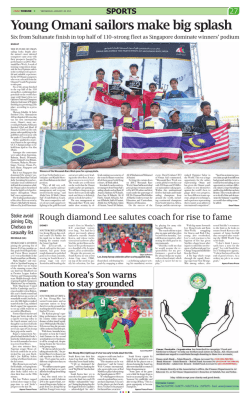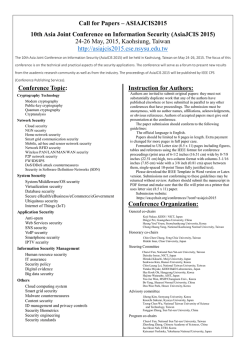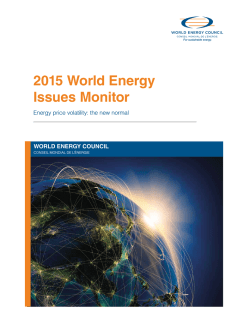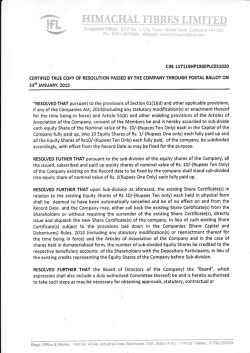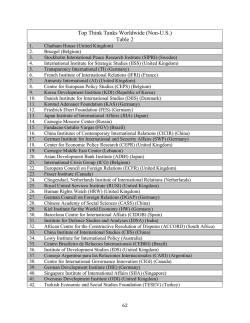
Quarterly Activities Report - Australian Securities Exchange
For personal use only QUARTERLY ACTIVITIES REPORT PERIOD ENDING 31 DECEMBER 2014 ASX CODE: SHE Stonehenge Metals Limited ABN 81 119 267 391 HIGHLIGHTS Stonehenge settles option to acquire breakthrough Protean wave energy technology Stonehenge signs binding JV agreement with KORID Non-renounceable Rights Issue raises $1,503,643 Office J, Level 2, 1139 Hay Street West Perth WA 6001 T: +61 8 9481 2277 www.stonehengemetals.com.au Enquiries regarding this report may be directed to: Stonehenge Metals Limited (ASX:SHE) (Stonehenge or the Company) is pleased to provide shareholders with the following quarterly activities report for the December quarter. Bruce Lane Managing Director Breakthrough Wave Technology Matthew Foy Company Secretary During the quarter, the Company advised it had executed formal transaction documents and completed the option agreement with Protean Energy Ltd (PEL). The option agreement with PEL grants Stonehenge an exclusive 24 month global licence and an option to acquire 100% of the equity of Protean Energy Australia Pty Ltd (PEA) (the Option). PEA holds the intellectual property titles, rights and licenses to the Protean Wave Energy Converter Technology (Protean WEC). Page 1 of 11 The Protean WEC is positioned to carve out a stake in the rapidly growing global renewable energy market tipped to be worth over $600BN by 20151. Wave energy converters offer significant energy supply potential due to wave energy’s density being many times greater than that of solar or wind energy. For personal use only The Protean™ Wave Energy Converter (WEC) is targeted to disrupt the global renewable energy market through its potential to provide a scalable cost effective renewable energy solution2. The Protean WEC has been independently assessed by two reputable independent bodies and Stonehenge believes it offers compelling advantages over other renewable energy systems. Stonehenge intends to assess the potential of the Protean WEC to create a step change in renewable energy production by: Refining the proven scale device to rapidly deliver a pre-commercial pilot model; Deploying an array of Protean WEC devices to provide scalable power to a prospective customer; Testing the Protean array & transmission setup in preparation for commercial trials; Verifying the testing results through independent technical experts; and Commercialising the power generation array initially for small to medium customers. Protean WEC Technology Summary The Protean system is based upon a point-absorber wave energy converter buoy device which floats at the water surface and extracts energy from the waves by the extension and retraction of a tether to its anchoring weight on the sea bed. The device is unique in that it optimises the conversion of energy from waves through all six degrees of wave movement or motion. Figure 1: Protean WEC technology The Protean WEC has been trialled at a 1.5 metre wide scale in the sea off Perth, proving the system can successfully convert the power from waves into usable energy. 1 According to the new market research report ‘Global Renewable Energy Market Outlook (2008 – 2015), published by MarketsandMarkets, the global renewable energy market is expected to reach a size of $614.92 billion by 2015 at a CAGR of 7.5% from 2010-2015. 2 Protean WEC Technology projected energy cost assessments were derived from a commercially confidential report titled: Protean Energy – Wave Energy Converter Independent Review Report (2011). As part of its assessment during the course of the Option period, Stonehenge intends to commission its own independent technical report to verify the Levelised Cost of Energy (LCOE) of the Protean device used in prototype trials. Page 2 of 11 For personal use only Figure 2: Protean WEC ready for deployment The Protean WEC uses compact architecture to produce power very efficiently from a small, low cost design targeted at keeping the projected levelised cost of energy (LCOE)3 down. Figure 3: Dimensions of selected wave energy technologies4 The Protean WEC has been designed to be an efficient converter of wave energy and cost competitive to manufacture, deploy, maintain and retrieve. The future plans for the Protean WEC include the deployment of a pre-commercial demonstration of a dynamic, configurable and scalable power array prior to moving the technology into early commercialisation. During the Option period the Stonehenge assessment program aims to: 1. Refine the tried and proven scale device to produce a suitable pre-commercial model; 3 Levelised cost of energy is one of the industry’s main metrics for the cost of electricity produced. It accounts for all of a system’s expected lifetime costs (incl. construction, finance, fuel, maintenance, tax, insurance & incentives), which are then divided by the system’s lifetime expected power output (kWh) & discounted for inflation & time cost of money. 4 The image in Figure 3 above is a representation based on publicly available information for competitors 1 & 2 compared with as yet untested projections for a larger scale Protean device used in an offshore environment. The competitor 1 & 2 devices depicted are for illustration purposes only & may not be the only or most recent devices offered by any competitor. Page 3 of 11 2. Create a scalable power array from the pre-commercial model so as to provide the power requirements of a prospective customer; 3. Test the scalable power array for its potential to delivery cost effective power; 4. Verify the results, including commissioning an independent expert to qualify the testing results; and 5. Commence commercialisation of the scalable array of the trials for small to medium customers. For personal use only Protean’s “New Wave” in Wave Energy Conversion The Protean system is based upon an internationally patented and patent pending intellectual property invented by Sean Moore5 that has attracted interest from around the globe. The Protean WEC Technology has been identified as having a number of significant advantages over other wave energy technologies currently being investigated internationally. The most significant of these advantages is its capacity to harness energy from all 6 of the available directional wave forces. This capability has been successfully trialled, with results reviewed by Murdoch University in Western Australia. Furthermore it is believed that the Protean WEC Technology is the only known wave energy system that uses all 6 degrees of wave movement (being: up-down, side-to-side, forward-backward, and rotation about each of these axes). Other wave energy systems typically use one or two degrees of movement, which can significantly reduce their productivity. Protean is based on globally accepted and proven ocean buoy technology and is designed to withstand the harsh ocean environment; a critical issue for wave energy conversion systems. Major benefits designed into the system include: Scalability – the Protean system is designed to provide low cost energy for a wide range of applications, from small to large scale production. Versatility – the Protean system has been designed for dedicated or simultaneous production of electricity or the desalination of seawater to drinking water quality. Affordability – the Protean was designed from the ground up to provide cost effect, consistent and reliable renewable energy in lower & higher energy wave resource locations. The Protean WEC is designed for cost effective manufacture, deployment, maintenance and retrieval. Figure 4: Comparison of levelised cost for common sources of renewable energy6 5 Sean Target area of opportunity for the Protean WEC Moore holds degrees in science & engineering and has been researching and developing ocean energy technologies since 2004. Mr Moore has been the recipient of numerous awards and scholarships as well as being an international speaker on wave energy. During late 2009 Mr Moore was recognised for his expertise in ocean energy and was invited to be a panellist on the highly popular Ocean Energy Panel at the inaugural 2009 Asia Pacific Clean Energy Summit in Hawaii. 6 The Company believes that these figures are indicative industry recognised values for cost per MWh for each respective renewable energy and this chart is derived from Bloomberg New Energy Finance as published by the International Energy Agency at the following web address; https://www.iea.org/media/workshops/2014/solarelectricity/BNEF2LCOEofPV.pdf Page 4 of 11 Binding JV Agreement Signed with Korea Resources Investments & Development Inc. (KORID) For personal use only During the quarter the Company advised it had entered into a binding term sheet joint venture (JV) agreement (Term Sheet) with Korea Resources Investment & Development Inc. (KORID). The JV agreement creates a framework for KORID and Stonehenge to work together to accelerate the development of the mineral exploration rights and properties held by the Stonehenge’s wholly owned Korean subsidiary, Stonehenge Korea Ltd (SHEK). The JV will initially focus on conducting work which will contribute to the preparation of pre-feasibility study (PFS) for the Daejon vanadium and uranium project. The JV will focus on: Working towards a collaboration with KIGAM to test up to 36,000 metres of mineralised historical core (from Stonehenge’s Daejon Project area) stored at KIGAM; Significantly upgrading the current Daejon Project vanadium and uranium resource estimates in size and or confidence as a result of testing the core at KIGAM; Preparing a pre-feasibility study; and Preparing work programs and budgets to support completion of a definitive or bankable feasibility study. The binding Term Sheet stipulates the exchange of equity between Stonehenge (via SHEK) and KORID such that SHEK will be 50% owned and controlled by both Stonehenge and KORID. Key Terms of the Transaction (a) The Term Sheet sets out the terms on which Stonehenge agrees to sell 50% of the issued capital in its 100% owned Korean subsidiary, Stonehenge Korea Ltd (SHEK), to KORID. (b) KORID will pay Stonehenge $2.5m in consideration for the purchase of 50% of the shares in SHEK. The consideration will be paid through the issue by KORID of KOSDAQ listed shares in KORID with a 12 month escrow. (c) The Parties agree that it is their common intention, through the sale and purchase of shares in SHEK and the Formal Documentation, to co-fund and accelerate development of the mineral exploration rights and properties held by SHEK with particular focus on the Daejon Project. The relationship between the parties in respect of SHEK will be governed by the constitution of SHEK and the Shareholders Agreement; the key terms of which are included below and in the Term Sheet. The parties agree that development of the Daejon Project including completion of a Pre-Feasibility Study (PFS) is their primary objective and as such there are expected to be three phases of development and funding, with all funding costs after Stage 1 shared in proportion to the parties’ percentage shareholding in SHEK, as follows: (i) Stage 1 – within 18 months from the date of Completion, achieving access to and completing testing of 36,000 metres of historical drill core (held by KIGAM) and upgrading the existing uranium and vanadium resources in accordance with the JORC code (2012). SHE to provide $700,000 in cash funding. KORID to provide $300,000 in cash funding (via the Placements) and $200,000 of Korean in country services, assistance or facilities as requested by SHEK with the valuation to be determined by SHEK. (ii) Stage 2 – within 3 years from the date of Completion, undertaking further field work, drilling and resource definition work as required to more accurately define economic resources and a preliminary mining plan. Estimated Total Cost $1 million to be funded by SHE and KORID in proportion to their shareholdings in SHEK (iii) Stage 3 – within 4 years of the date of Completion, achieving the development of a PFS to a sufficient standard for the purposes of illustrating potential return on investment scenarios which will in turn support efforts to secure a future Korean development partner. This will be funded by SHE and KORID in proportion to their SHEK shareholdings. Page 5 of 11 (d) The Parties have agreed that, subject to shareholder and regulatory approvals if required, KORID will subscribe for $300,000 in SHE Shares in three tranches as follows (together The Placements): For personal use only (i) Placement 1: $100,000 on the date that is 6 months from the date of Completion (Placement 1 Date) and at a price equal to the Volume Weighted Average Price (VWAP) of SHE shares traded on ASX during the 15 traded days prior to Placement 1 Date. These shares will be escrowed for 6 months from their date of issue; (ii) Placement 2: $100,000 on a date that is 9 months from the date of Completion (Placement 2 Date) and at a price equal to the VWAP of SHE shares traded on ASX during the 15 traded days prior to Placement 2 Date. These shares will be escrowed for 3 months from their date of issue; and (iii) Placement 3: $100,000 on the date that is 12 months from the date of Completion (Placement 3 Date) and at a price equal to the VWAP of SHE shares traded on ASX during the 15 traded days prior to Placement 3 Date. (e) This Term Sheet and the Formal Documentation stipulate the development objectives for the Daejon Project and provide terms of reference for future collaboration on New Projects introduced by KORID or Stonehenge. (f) The Term Sheet and the transactions contemplated therein remain subject to detailed tax and regulatory reviews and as such the terms of this agreement may need to be changed to avoid any deleterious taxation or regulatory outcomes. (g) Completion is conditional upon and subject to the following conditions being satisfied or waived no later than 120 days from the date of this Term Sheet or such other date as the Parties agree: (i) all loans from SHE to SHEK being converted into equity in SHEK to a maximum value of $5m (ii) KORID conducting due diligence enquiries with respect to SHEK and, being satisfied with the results of those enquiries at its absolute discretion, notifying SHE of the successful completion of due diligence; (iii) if required, the shareholders of KORID or any relevant governmental or regulatory body of the Republic of Korea approving the transactions contemplated by this Term Sheet; (iv) if required under the Corporations Act, the Constitution of SHE or the ASX Listing Rules, the shareholders of SHE approving the transactions contemplated by this Term Sheet; (v) the parties entering into the Formal Documentation; and (vi) KORID providing the nominations and consents of two directors to the board of SHEK. (together the Pre-Conditions to Completion). The Pre-Conditions to Completion must be satisfied or waived no later than 120 days from the date of this Term Sheet or such other date as the parties agree in writing (Pre-Condition End Date). (h) Shareholders Agreement - the parties agree to enter into a Shareholders Agreement on terms not materially inconsistent with those specified below. (i) The board of SHEK shall be composed of two representatives each from KORID and SHE; (ii) The board of SHEK will appoint a manager or management committee to prepare a business plan including budgets and work programs. This business plan will be agreed annually by the board and updated quarterly. The manager or management committee will be responsible for carrying out and regularly reporting on approved work programs; (iii) Funding drawdowns will be agreed by the board of SHEK and Drawdown Notices will be issued to the Parties by the board of SHEK in a timely fashion; (iv) The parties will agree to restrictions on the transfer of their shares, pre-emptive rights and drag along/come along provisions. (v) The parties will provide warranties normally found in an agreement of this type. Page 6 of 11 (vi) The parties agree to be bound by the constitution of SHEK and the Shareholders Agreement and where there is inconsistency the Shareholders Agreement will take precedence. In the event that the objectives set out in Stage 1, as per (c) (i) above are not achieved within 12 months of Completion (or such other time as agreed) then, after 12 months, either Party can elect to terminate this agreement in writing with 1 months’ notice to the other Party. (j) If, at any stage after the objectives set out in (c) (i) (Stage 1) are achieved, and either of the parties subsequently is unable to, or elects not to, provide funding to advance Stage 2 or Stage 3 of the Daejon Project development program a specified Dilution Formula will apply. In addition the party that withdraws from funding must use reasonable endeavours to find an alternative funding partner that meets the approval of the other party. For personal use only (i) In addition, the parties wish to contemporaneously work collaboratively to advance the evaluation and development of other potential minerals projects (New Projects) introduced by KORID or Stonehenge. The collaboration activities of the parties will be defined by a separate Collaboration Agreement (Collaboration Agreement). The parties agree to enter into the Collaboration Agreement on terms including those specified below and otherwise on terms consistent with agreements of this type. About KORID KORID is a Korean public company listed on KOSDAQ7. KORID is focused on developing mineral and energy resources and operates successful exploration and mining operations in many locations including Indonesia, Peru and Mongolia. KORID has existing partnership agreements with a number of parties, including KIGAM 8 and KORES9, for exploration and development of mineral resources. More information about KORID can be found at their website. Corporate Placement of Shortfall Shares following Rights Issue During the quarter, the Company advised that CPS Capital, acting as Lead Manager to the recently completed Rights Issue has successfully placed 170,843,368 Shortfall Shares at 0.5¢ to raise a further $854,217. The placement of Shortfall Shares brings the total raised under the Rights Issue to $1,503,643. The placement of the Shortfall Shares satisfied a key condition precedent to settlement of the acquisition of an exclusive 24 month unrestricted licence and option to acquire 100% of the equity of Protean Energy Australia Pty Ltd (PEA) (the Option). Appointment of Chief Technology Officer (Wave Energy) and Managing Director As a result of completion of the transaction with PEL, Mr Sean Moore (the Protean WEC inventor) and Mr Bruce Lane have now both commenced in their respective roles of Chief Technology Officer (Wave Energy) and Managing Director. Conversion of Convertible Notes On 24 November 2014 the Company advised that the outstanding convertible loan notes had been converted into 30,000,000 ordinary shares following shareholder approval at a general meeting held on 11 November 2014. 7 Korean Securities Dealers Automated Quotations or KOSDAQ is the SME trading board of the main South Korean Exchange (KRX) with approximately 1,000 companies listed. 8 Korea Institute of Geoscience and Mineral Resources (KIGAM) is a research institute under the umbrella of the Korean Ministry of Trade, Industry and Energy. 9 Korea Resources Corporation (KORES) specialises in mineral resources information, research and development in Korea. KORES is based in Seoul and focuses on supplying energy and industrial mineral resources including coal, uranium, iron, copper, zinc, and nickel with branch offices in Toronto, Lima, Sydney, Beijing, Pretoria, Almaty, Jakarta & Kinshasa. Page 7 of 11 Option Lapse On 12 December 2014 the Company advised that 1,235,883 options exercisable at $0.075 on or before 12 December 2014 had lapsed unexercised. For personal use only During the quarter the Company has also agreed to provide PEL with a working capital loan of up to $30,000, secured against the assets of PEL. Capital Structure Following the placement of shortfall shares under the Rights Issue and completion of the option agreement with PEA the Company’s capital structure consists of the following: - 847,534,700 ordinary shares. - 30,000,000 Performance Rights. - 5,000,000 Class F Performance Shares. - 7,500,000 Class G Performance Shares. For further information visit: www.stonehengemetals.com.au or www.proteanwavenergy.com.au Stonehenge Metals Limited Bruce Lane – Executive Director T: + 61 8 9481 2276 E: [email protected] Page 8 of 11 ABOUT STONEHENGE METALS For personal use only Stonehenge Metals Limited (ASX Code: SHE) is developing a multi-mineral project in South Korea. Stonehenge owns 100% of the rights to three projects in South Korea, including the Company’s flagship Daejon Project, which contains the largest uranium resource within South Korea at 66.7Mlbs grading 329ppm U3O8 at a cutoff of 200ppm U3O8 (JORC 2004 compliant). Recently, the Company established a maiden vanadium resource of 17.3Mlbs (largely indicated) grading 3,186ppm V2O5 at a cut-off of 2,000ppm V2O5. South Korean Project Locations U3O8 Mineral Resource Estimate at a 200 ppm U3O8 cut-off Indicated - Chubu Tonnes Mt 3.3 Grade ppm 247 Metal Mlbs 1.8 Inferred - Chubu 45.9 335 33.9 Sub-Total Chubu 49.2 329 35.7 Inferred - Yokwang 39 310 26 Inferred - Kolnami Total 7 95.2 340 329 5 66.7 Classification V2O5 Mineral Resource Estimate at a 2,000 ppm V2O5 cut-off Indicated Tonnage Mt 2.3 Grade ppm 3,208 Metal Mlbs 16.5 Inferred 0.1 2,788 0.8 Total 2.5 3,186 17.3 Classification Vanadium Exploration Target1 Tonnes (Mt) Grade V2O5 (ppm) Contained V2O5 (Mlbs) 70 - 90 2,500 - 3,500 385 - 695 Tonnes (Mt) 15 - 59 Uranium Exploration Target1 Grade U3O8 (ppm) Contained U3O8 (Mlbs) 300 - 500 17-39 1 The potential quantity & grade of the exploration target is conceptual in nature, there has been insufficient exploration to define a Mineral Resource & it is uncertain if further exploration will result in the definition of a Mineral Resource. The vanadium and uranium exploration targets are based on exploration results from the 2013 drilling at Chubu & Gwesan (refer announcements 15 July & 13 November 2013) that demonstrated vanadium and uranium mineralisation through the black shales. The geology in the Okcheon belt consists of a meta-sedimentary sequence that comprises three formations, Wunkyori, Hwajeonri & Guryongsan. The stratigraphic sequence within the belt at the Gwesan project comprises dark grey phyllite, overlain by the black shale (ore zone) & a fine grained sandstone. The historical drilling at the Gwesan project has demonstrated black shale deposits along 10km of strike. KORES completed three drill holes targeting the mineralised black shale at Gwesan in order to verify the mineralisation zone throughout the area. All three holes were drilled to a total depth of 100m and several ore zones between 3m and 11m have been intercepted in each drill hole. The best intercept of 3500 ppm V2O5 & <10 ppm U3O8 in the first hole provides encouraging results (refer ASX announcement 13 Nov 2013). More drilling will be required to define the high grade mineralisation zone in the area. The mineralisation remains open at depth & along the 10km strike. The project is in its exploration stage and the additional drilling is expected to increase the potential to discover high class uranium and vanadium Mineral Resources at Gwesan. Stonehenge expects to test the validity of the exploration target Page 9 of 11 once access to historical drill core is obtained and the Company is able to assay the core for vanadium mineralisation. For personal use only The Company is continuing its efforts to access the core and further updates on this progress will be advised as soon as it becomes available. This information was prepared and first disclosed under the JORC Code 2004 (refer ASX announcement 29 August 2013). It has not been updated since to comply with the JORC Code 2012 on the basis that the information has not materially changed since it was last reported. Competent Person’s statement The information contained in this ASX release relating to exploration results and Mineral Resources has been compiled by Mr. Ian Glacken of Optiro Ltd. Mr. Glacken is a Fellow of The Australian Institute of Mining and Metallurgy and has sufficient experience which is relevant to the style of mineralisation and type of deposit under consideration and to the activity which he is undertaking to qualify as a Competent Person as defined in the 2012 Edition of the “Australasian Code for Reporting of Exploration Results, Mineral Resources and Ore Reserves”. Mr Glacken consents to the inclusion in the report of the matters based on his information in the form and context in which it appears. Page 10 of 11 Appendix 1 - Stonehenge Tenement Details For personal use only Registration Number Land Register Number Area (ha) Interest 100% 76967 Gwesan 114 275 76942 Gwesan 115 275 76965 Gwesan 117 275 76966 Gwesan 118 275 76964 Gwesan 124 275 76941 Gwesan 125 275 76968 Gwesan 126 275 76969 Gwesan 128 275 79161 Gwesan 137 275 77018 Miwon 36 276 77019 Miwon 46 276 77020 Miwon 58 276 77225 Miwon 37 276 77291 Miwon 47 276 77292 Miwon 57 276 77010 Okcheon 136 138 77011 Daejon 18 277 77012 Daejon 28 259 77013 Daejon 38 277 77014 Daejon 48 277 77038 Ogchon 147 277 % 100% 100% 100% 100% 100% 100% 100% 100% 100% 100% 100% 100% 100% Registration Date Registrant 28/05/2008 Stonehenge Korea 14/05/2008 Stonehenge Korea 28/05/2008 Stonehenge Korea 28/05/2008 Stonehenge Korea 28/05/2008 Stonehenge Korea 14/05/2008 Stonehenge Korea 28/05/2008 Stonehenge Korea 28/05/2008 Stonehenge Korea 12/01/2011 Stonehenge Korea 11/06/2008 Stonehenge Korea 11/06/2008 Stonehenge Korea 11/06/2008 Stonehenge Korea 21/08/2008 Stonehenge Korea 23/09/2009 Stonehenge Korea 23/09/2009 Stonehenge Korea 10/06/2008 Stonehenge Korea 10/06/2008 Stonehenge Korea 10/06/2008 Stonehenge Korea 10/06/2008 Stonehenge Korea 3/07/2008 Stonehenge Korea 19/06/2008 Stonehenge Korea 19/06/2008 Stonehenge Korea 3/07/2008 Stonehenge Korea 3/07/2008 Stonehenge Korea 16/10/2008 Stonehenge Korea 16/10/2008 Stonehenge Korea 18/12/2012 Stonehenge Korea Property Goesan [Gwesan] Miwon 100% 77039 Daejon 17 103 77114 Daejon 7 190 77115 Daejon 27 56 77363 Daejon 47 242 77364 Daejon 57 186 200204 Daejon 59 228 100% 100% 100% 100% 100% 100% 100% 100% 100% 100% 100% 100% Daejon [Daejeon] Page 11 of 11
© Copyright 2025
